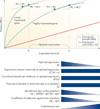Determinants of the rate of protein sequence evolution
- PMID: 26055156
- PMCID: PMC4523088
- DOI: 10.1038/nrg3950
Determinants of the rate of protein sequence evolution
Abstract
The rate and mechanism of protein sequence evolution have been central questions in evolutionary biology since the 1960s. Although the rate of protein sequence evolution depends primarily on the level of functional constraint, exactly what determines functional constraint has remained unclear. The increasing availability of genomic data has enabled much needed empirical examinations on the nature of functional constraint. These studies found that the evolutionary rate of a protein is predominantly influenced by its expression level rather than functional importance. A combination of theoretical and empirical analyses has identified multiple mechanisms behind these observations and demonstrated a prominent role in protein evolution of selection against errors in molecular and cellular processes.
Figures



References
-
- Zuckerkandl E, Pauling L. In: Horizons in Biochemistry. Kasha M, Pullman B, editors. New York: Academic Press; 1962. pp. 189–225.
-
- Zuckerkandl E, Pauling L. In: Evolving Genes and Proteins. Bryson V, Vogel HJ, editors. New York: Academic Press; 1965. pp. 97–166. - PubMed
-
- Kimura M. Evolutionary rate at the molecular level. Nature. 1968;217:624–626. - PubMed
-
- Kumar S. Molecular clocks: four decades of evolution. Nat Rev Genet. 2005;6:654–662. - PubMed
Publication types
MeSH terms
Substances
Grants and funding
LinkOut - more resources
Full Text Sources
Other Literature Sources

